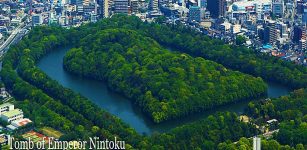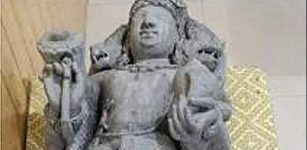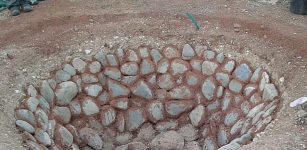Chaco Canyon’s Piedra del Sol Petroglyph Depicts An Ancient Total Eclipse Visible In The Year 1097
A. Sutherland - AncientPages.com - There are many fascinating ancient petroglyphs in Chaco Canyon, New Mexico. Among them is one that researchers think represents an ancient total eclipse seen by people on July 11, 1097.
Ancient people watched the skies just like we do today and they were curious, fascinating, and sometimes frightened. Many ancient civilizations considered an eclipse to be a sign of bad omen.
Throughout history, lunar eclipses have been held to be responsible for lost battles and many other tragic events on Earth. Solar eclipses, known as chi’ ibal kin, or “to eat the sun,” were a particular cause for distress among the Maya people.
Pueblo Bonito Kiva and Complex at Chaco - Image credit: Earth Walks
What people in Chaco Canyon thought of this eclipse is unknown, but it seems they wanted to preserve the memory of these astronomical events for future generations.
People In Chaco Canyon Depicted A Coronal Mass Ejection
According to Professor Emeritus J. McKim “Kim” Malville from the University of Colorado Boulder, the petroglyph that is carved in a rock by early Pueblo people is a circle that resembles the Sun’s outer atmosphere known as its corona, with tangled protrusions looping off the edges.
“To me it looks like a circular feature with curved tangles and structures,” said Professor Malville of CU Boulder’s astrophysical and planetary sciences department.
Piedra del Sol petroglyph - Image credit: University Of Colorado
“If one looks at a drawing by a German astronomer of the 1860 total solar eclipse during high solar activity, rays and loops similar to those depicted in the Chaco petroglyph are visible.”
One tangled loop jutting from the petroglyph circle may illustrate a coronal mass ejection (CME), an eruption that can blow billions of tons of plasma from the sun at several million miles per hour during active solar maximum periods. But if the sun was in a “quiet phase” of its roughly 11-year cycle, one would expect few if any CMEs, and the likelihood of one occurring during a solar eclipse would be negligible, Malville said.
“This was a testable hypothesis,” Malville said. “It turns out the sun was in a period of very high solar activity at that time, consistent with an active corona and CMEs.”
Evidence Of An Ecplise In 1097
The petroglyph in Chaco Canyon is not the only evidence of an eclipse in 1097. Professor Malville said that this astronomical event has been confirmed with help of data from ancient tree rings. Such tree rings form every year and they have been cross-dated to create time series going back thousands of years and which also contain traces of the isotope carbon-14. Created by cosmic rays hitting Earth’s atmosphere, carbon-14 amounts in the tree rings can be correlated with sunspots—the less carbon-14, the more sunspots, which indicates higher solar activity.
Chaco Canyon's petroglyphs - Image credit: University Of Colorado
Researchers have also examined records of naked-eye observations of sunspots, which go back several thousand years in China. A third method involved looking at historical data compiled by northern Europeans on the annual number of so-called “auroral nights,” when the northern lights were visible, an indication of intense solar activity.
Piedra del Sol Is A Possible Eclipse Petroglyph
Professor Malville said that he and his team are convinced everything suggests Piedra del Sol is a possible eclipse petroglyph. On its east side, it has a large spiral petroglyph that marks sunrise 15 to 17 days before the June solstice.
A triangular shadow cast by a large rock on the horizon crosses the center of the spiral at that time. Such a phenomenon may have been used to start a countdown to the summer solstice and related festivities, he said.
Piedra del Sol petroglyph - Image credit: University Of Colorado
On one side of the petroglyph, there is also a bowl-shaped depression that Professor Malville thinks was used by people as place corn as offerings.
The southwest side of the rock faces a small butte on the horizon that marks the December solstice event, and the rock also has carved steps, indicating it likely had some kind of ceremonial importance, he said.
Anasazi pictograph possibly depicting the Crab Nebula supernova in AD 1054. Chaco Canyon, New Mexico
“This possible eclipse petroglyph on Piedra del Sol is the only one we know of in Chaco Canyon,” Professor Malville said. “I think it is quite possible that the Chacoan people may have congregated around Piedra del Sol at certain times of the year and were watching the sun move away from the summer solstice when the eclipse occurred.”
Two other Chaco Canyon rock art pieces may be related to astronomical events, Malville said. One is thought by some to be a depiction of an A.D. 1054 supernova bright enough to be visible in the daytime for several weeks, while another resembles a comet, perhaps Halley’s Comet, which would have been visible from there in A.D. 1066.
“The appearance of the spectacular supernova and comet may have alerted the residents of the canyon to pay attention to powerful and meaningful events in the sky,” he said.
Written by: A. Sutherland AncientPages.com
Expand for references
























